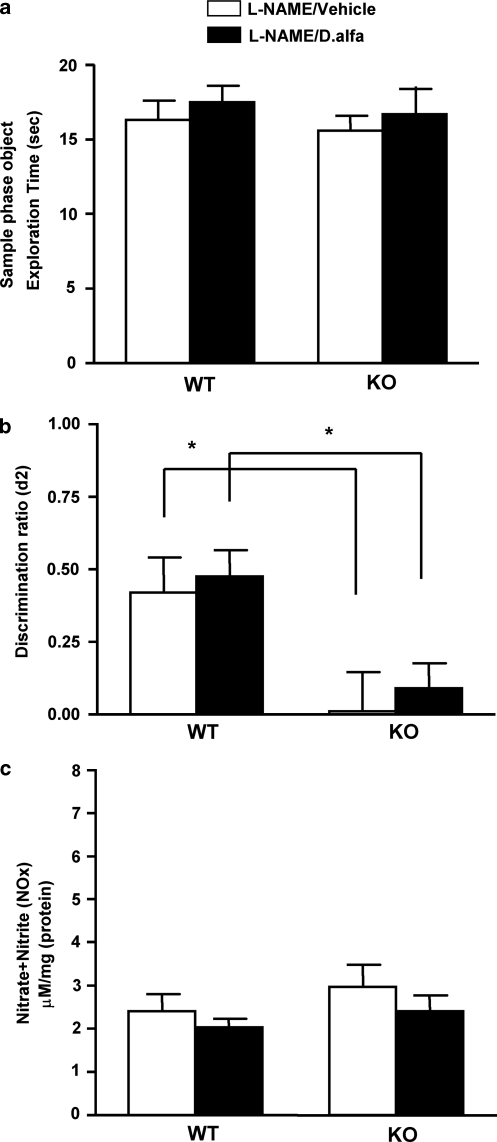Figure 5.
-NAME inhibits the improvement in NORT performance and the increase of NOx levels of STOP null mice that received D. alfa. Wild-type (WT) or STOP null mice (KO) were treated with -NAME (25 mg/kg, i.p.) and vehicle (10 mg/kg, i.p.; WT: N=8, KO: N=8) or -NAME (25 mg/kg, i.p.) and D. alfa (25 μg/kg, i.p.; WT: N=9, KO: N=8). The first injection occurred 30 min before the second. NORT was performed 3 h after D. alfa treatment, and then hippocampi were subjected to measurement of NOx levels. (a) Object exploration time in sample phase for WT and KO treated with -NAME (25 mg/kg, i.p.) and vehicle (10 mg/kg, i.p.) or -NAME (25 mg/kg, i.p.) and D. alfa (25 μg/kg, i.p.). Each bar represents mean±SEM. All four groups spent an equivalent amount of time investigating the objects during the sample phase. (b) Discrimination ratio (d2) in choice phase for WT or KO treated with -NAME (25 mg/kg, i.p.) and vehicle (10 mg/kg, i.p.) or -NAME (25 mg/kg, i.p.) and D. alfa (25 μg/kg, i.p.). Each bar represents mean±SEM. -NAME (25 mg/kg, i.p.) blocked the ability of D. alfa (25 μg/kg, i.p.) to improve NORT performance of KO. White bars, -NAME (25 mg/kg) and vehicle (10 ml/kg); black bars, -NAME (25 mg/kg) and D.alfa (25 μg/kg). Two-way ANOVA with Bonferroni post hoc t-test, *p<0.05. (c) -NAME inhibited the increase in nitrate and nitrite (NOx) levels induced by D. alfa in the hippocampus of wild-type and STOP null mice. The hippocampi from all animals were immediately removed and NOx measurements performed. NOx levels (μM/mg (protein)) are shown in the bar graph as mean±SEM. -NAME (25 mg/kg, i.p.) blocked the ability of D. alfa (25 μg/kg, i.p.) to increase NOx levels in both WT and KO mice. White bars, -NAME (25 mg/kg, i.p.) and vehicle (10 ml/kg, i.p.); black bars, -NAME (25 mg/kg, i.p.) and D.alfa (25 μg/kg, i.p.). There were no statistically significant differences among the groups, two-way ANOVA.

